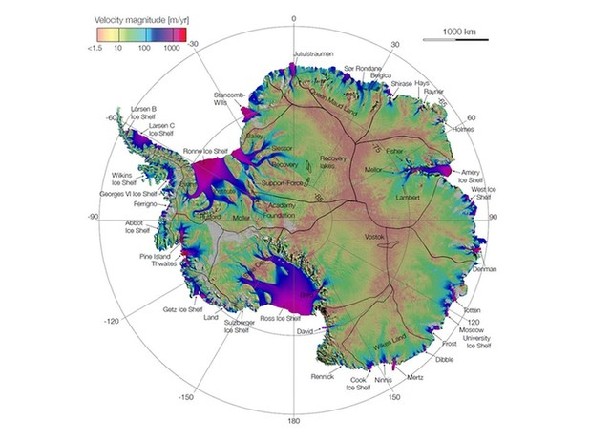NASA to complete 1st map of Antarctic ice flow
 0 Comment(s)
0 Comment(s) Print
Print E-mail
Xinhua, August 19, 2011
E-mail
Xinhua, August 19, 2011
Using integrated radar observations from a consortium of international satellites, NASA- funded researchers have created the first complete map of the speed and direction of ice flow in Antarctica, the U.S. National Aeronautics and Space Administration (NASA) announced Thursday.
|
|
|
First complete map of the speed and direction of ice flow in Antarctica, derived from radar interferometric data. [ibtimes.com] |
The map, which shows glaciers flowing thousands of miles from the continent's deep interior to its coast, will be critical for tracking future sea-level increases from climate change.
"This is like seeing a map of all the oceans' currents for the first time. It's a game changer for glaciology," said Eric Rignot of NASA's Jet Propulsion Laboratory and the University of California (UC), Irvine. Rignot is lead author of a paper about the ice flow published online Thursday in Science Express. "We are seeing amazing flows from the heart of the continent that had never been described before."
Rignot and UC Irvine scientists used billions of data points captured by European, Japanese and Canadian satellites to weed out cloud cover, solar glare and land features masking the glaciers. With the aid of NASA technology, the team painstakingly pieced together the shape and velocity of glacial formations, including the previously uncharted East Antarctica, which comprises 77 percent of the continent.
Like viewing a completed jigsaw puzzle, the scientists were surprised when they stood back and took in the full picture. They discovered a new ridge splitting the 5.4-million-square-mile landmass from east to west.
The team also found unnamed formations moving up to 800 feet annually across immense plains sloping toward the Antarctic Ocean and in a different manner than past models of ice migration.
"The map points out something fundamentally new: that ice moves by slipping along the ground it rests on," said Thomas Wagner, NASA's cryospheric program scientist in Washington. "That's critical knowledge for predicting future sea level rise. It means that if we lose ice at the coasts from the warming ocean, we open the tap to massive amounts of ice in the interior."






